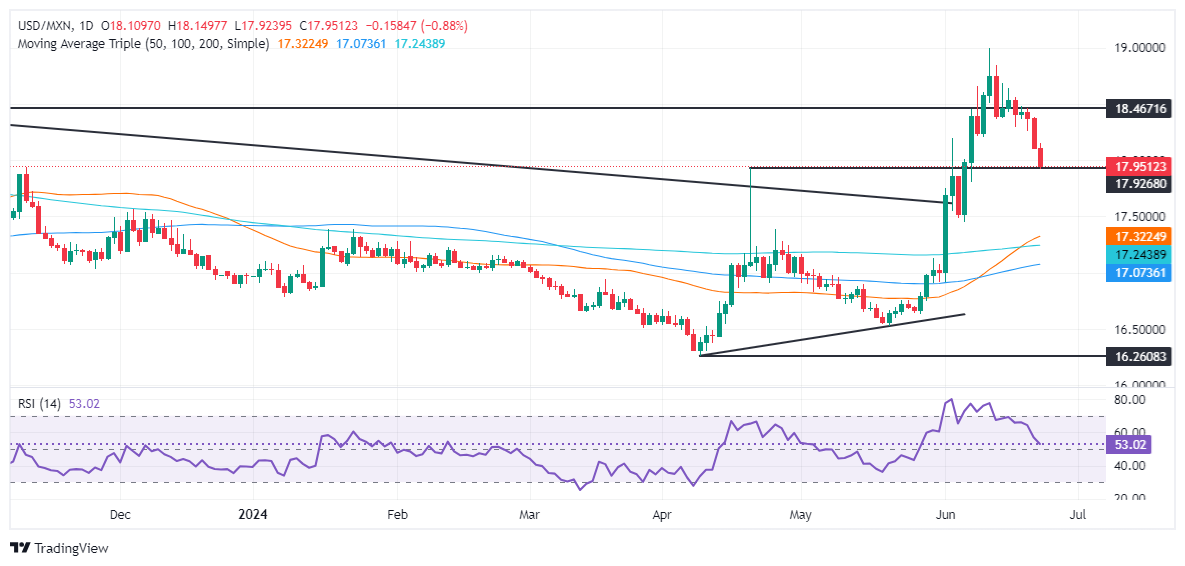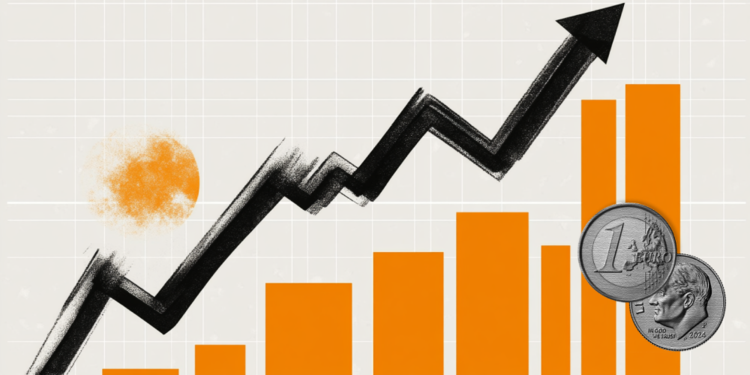- The Mexican Peso appreciates for the third consecutive day, reaching a daily minimum below 18.00 against the US Dollar.
- Inflation data for mid-June shows a decline in core numbers, while headline inflation expands but stagnates compared to May.
- Analysts revise Banxico rate cut expectations from June to August, with the Citibanamex survey adjusting the USD/MXN forecast from 18.00 to 18.70.
The Mexican peso recovered and appreciated for the third consecutive day of trading against the US dollar, as investors prepared for the next monetary policy decision from the Bank of Mexico (Banxico) on Thursday. Analysts became more skeptical that the Mexican institution would lower rates following a depreciation of more than 6.90% of the Peso after the June 2 general elections. USD/MXN is trading at 18.02, down 0.29%.
Mexico’s economic agenda presented inflation data for mid-June. Core numbers continued to decline, while headline inflation expanded above estimates but stagnated compared to May data. Following the data, USD/MXN fell to an 11-day low and tested the psychological level of 18.00 as investors prepare for Banxico’s decision.
The Citibanamex survey showed that most analysts seemed confident that Banxico would continue to ease policy, but they moved the next rate cut from June to August. Additionally, economists priced in fewer rate cuts by the central bank while adjusting the USD/MXN exchange rate forecast from 18.00 in the previous report to 18.70.
Regarding economic growth, the consensus revised the Gross Domestic Product (GDP) downwards for 2024 from 2.2% to 2.1% annually.
Across the border, Federal Reserve (Fed) officials remained cautious. Chicago Fed President Austan Goolsbee expressed that policy is restrictive and that he is optimistic that he will see an improvement in inflation data.
Daily summary of market drivers: The Mexican peso advances as inflation rises in June
- Mexico’s mid-June Consumer Price Index rose 0.21% monthly, above estimates, and expanded 4.78% annually, unchanged from the previous reading and above the estimate of 4.70%.
- Core inflation rose below estimates of 0.18% monthly, reaching 0.17%. On a yearly basis, it was below estimates and the previous reading of 4.17%.
- The Citibanamex survey showed that most analysts estimate that Banxico’s next rate cut will be at the August 8 meeting and that interest rates will be reduced from 11.00% to 10.5%, down from 10%.
- The USD/MXN stabilizes after last week’s verbal intervention by the governor of Banxico, Victoria Rodríguez Ceja, who stated that the central bank is attentive to the volatility in the exchange rate of the Mexican Peso and could restore the ” order” in the markets.
- USD/MXN is extending its losses due to a weaker US Dollar. The US Dollar Index (DXY), which tracks the value of the dollar against a basket of six other currencies, fell 0.28% to 105.53.
- The CME’s FedWatch tool shows odds of a 25 basis point Fed rate cut at 61.1%, up from 59.5% last Friday.
Technical Analysis: Mexican Peso Soars as USD/MXN Falls Below 18.00
The USD/MXN bullish trend remains, although the ongoing pullback from around 18.37 to below the 18.00 figure could pave the way to challenge the 50-day SMA at 17.37 before testing the 200-day SMA at 17.23. Once those two levels clear, the next stop would be the 100-day SMA at 17.06.
Although momentum shows that sellers are in charge, the Relative Strength Index (RSI) remains above the neutral line of 50. That said, traders should be cautious about whether USD/MXN could reverse its bearish trend in course.
For a bullish continuation, USD/MXN must break above 18.50 if buyers want to retest the year-to-date high of 18.99. A break of the latter will expose the March 20, 2023 high of 19.23. If that price clears, this will sponsor an increase to 19.50.
The Mexican Peso
The Mexican Peso is the legal tender of Mexico. The MXN is the most traded currency in Latin America and the third most traded on the American continent. The Mexican Peso is the first currency in the world to use the $ sign, prior to the later use of the Dollar. The Mexican Peso or MXN is divided into 100 cents.
Banxico is the Bank of Mexico, the country’s central bank. Created in 1925, it provides the national currency, the MXN, and its priority objective is to preserve its value over time. In addition, the Bank of Mexico manages the country’s international reserves, acts as a lender of last resort to the banks and advises the government economically and financially. Banxico uses the tools and techniques of monetary policy to meet its objective.
When inflation is high, the value of the Mexican Peso (MXN) tends to decrease. This implies an increase in the cost of living for Mexicans that affects their ability to invest and save. At a general level, inflation affects the Mexican economy because Mexico imports a significant amount of final consumption products, such as gas, fuel, food, clothing, etc., and a large amount of production inputs. On the other hand, the higher the inflation and debt, the less attractive the country is for investors.
The exchange rate between the USD and the MXN affects imports and exports between the United States and Mexico, and may affect demand and trade flows. The price of the Dollar against the Mexican Peso is affected by factors such as monetary policy, interest rates, the consumer price index, economic growth and some geopolitical decisions.
The exchange rate between the USD and the MXN affects imports and exports between the United States and Mexico, and may affect demand and trade flows. The price of the Dollar against the Mexican Peso is affected by factors such as monetary policy, interest rates, the consumer price index, economic growth and some geopolitical decisions.
Source: Fx Street
I am Joshua Winder, a senior-level journalist and editor at World Stock Market. I specialize in covering news related to the stock market and economic trends. With more than 8 years of experience in this field, I have become an expert in financial reporting.








